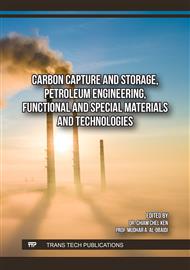p.37
p.49
p.61
p.71
p.89
p.101
p.117
p.125
p.139
Laboratory Evaluation of Sustainable Asphalt Mixture with Different Types of Solid Waste Material Using Modified Asphalt Binder (SBS)
Abstract:
Alternative approach. Incorporating these materials has the potential to protect the environment from pollution on one hand and modify the asphalt paving materials on the other hand. It can use these materials as a replacement for virgin aggregate. The waste materials recycled tire rubber have been evaluated as supplementary materials with (0.4, 0.8, 1.2 and 1.7) % by total weight of aggregate and retained on sieve (2.36, 0.3) mm, and the other waste material ( crushed glass waste ) was used in (5,15,25,30) % by the weight of aggregate on each sieve (4.75,2.36,0.3,0.075) mm. Styrene – Butadiene-Styrene (SBS) was used as an asphalt cement modifier, and it was added as a partial replacement of asphalt content with (4) % by weight of asphalt. Most of these waste materials can be classified as sustainable due to their origin from old scrap materials. This study objects to assess the influence of recycled tire Rubber ,crushed glass waste, and styrene butadiene styrenec on the performance and mechanical characteristics of asphalt mixtures and limestone utilized as mineral filler. The study involves creating a standards reference mixture for evaluation and two mixture with varying amounts of recycled asphalt paving. This experimental work used Marshall Properties, indirect tensile strength, and wheel track tests to determine the influence of varying waste materials on the performance of compacted asphalt paving materials on highways. In Summary, using CGW (Crushed Glass Waste), the mix's overall sustainability can be improved by lowering the amount of virgin materials needed. A binder changed by SBS can increase durability and resistance to rutting damage. 15 mm was the rutting depth at 5% CGW (Crushed Glass Waste), and 16.35 KN is the maximum rate for marshal stability. incorporating damaged tires into the asphalt mixture gives a stable product close to the reference mixture by about (15.35 KN) and ITS for conditioned and unconditioned was (1468,1275) . Finally, crushed glass waste and damaged tire waste in the asphalt mixture in certain proportions and only in fine aggregates and in specific gradations is recommended because it gives results comparable to the results of the reference mixture. Recycled glass is suitable for low-volume and low-speed highways, road bases, and recreational pavements like footpaths. Using (CGW and CR (Crumb Rubber )) in conjunction with SBS-modified binders within asphalt mixtures can enhance the resistance against moisture- induced damage and Rutting while enhancing the general durability and sustainability of hot asphalt mixes.
Info:
Periodical:
Pages:
139-163
Citation:
Online since:
November 2025
Authors:
Price:
Сopyright:
© 2025 Trans Tech Publications Ltd. All Rights Reserved
Share:
Citation:


